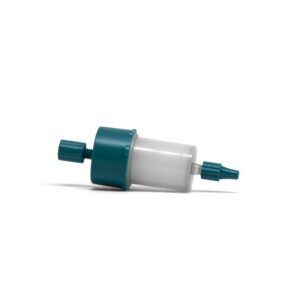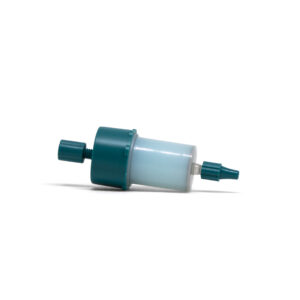Table 1. Resin Characteristics
| Bead Material
| Agarose |
| Bead Percentage
| 4% |
| Bead Size | 60-160 µm |
| Flow Rate1 | >20 mL/min (>680 cm/hr) @ 25oC |
| Binding Capacity (Hb)
| 3 - 5 mg of mannose containing glycoproteins |
| pH Stability2 | 3-12 |
| Storage Temperature | 2-8o C |
| Storage Buffer
| 10mM phosphate buffer, 150 mM NaCl, pH 7.5, containing 20 mM mannose and 0.05% sodium azide |
| Form | 50% Slurry
|
| Chemical Stability2 | Stable in commonly used aqueous buffers, salts, detergents, and reducing agents. Compatible with <8M Urea, <6M Guanidine HCl, and 1M NaOH. |
| Physical Stability2 | Negligible volume variation due to changes in pH or ionic strength. |
1Linear flow rate = volumetric flow rate (cm3/h)/column cross-sectional area (cm2)
2Data refer to the coupled product, provided that the ligand can withstand the pH or chemical environment. Please note the following: pH stability, long term refers to the pH interval where the medium is stable over a long period of time without adverse effects on its subsequent chromatographic performance. pH stability, short term refers to the pH interval for regeneration and cleaning procedures.
Instructions for Use
Galanthus nivalis Agglutinin (GNA) Superflow 4 is an affinity resin used to purify glycoproteins containing mannose sugars. The resin is prepared by covalently immobilizing purified GNA lectin to our highly crosslinked 4% agarose beads. GNA Superflow 4 is very stable resin with no sign of leaching at pH 3-12 and in various commonly used buffers. The resin can be used multiple times without any loss in binding capacity. Many enveloped viruses including HIV and SARS-CoV-2 contain mannose residues in their surface glycoproteins, thus GNA-Superflow 4 can be efficiently used in the purification of these viruses and respective surface glycoproteins for vaccine or structural studies.
GNA lectin is isolated from the bulbs of the snowdrop plant (Galanthus nivalis) by affinity purification on mannose-agarose resin. GNA is a tetramer of identical subunits and has a molecular mass of 52 kDa. Unlike other mannose-binding lectins GNA is not a metalloprotein and doesn’t require Ca++ or Mn++ for optimal binding activity. GNA shows strong affinity for structures containing (α 1-3) mannose residues, it agglutinates rabbit erythrocytes but not human erythrocytes. In human serum it binds to α2 macroglobulin and specifically binds murine IgM.
GNA Superflow 4 is supplied as 50% slurry in 10 mM phosphate buffer, 150 mM NaCl, pH 7.5 with 20 mM mannose and 0.05% sodium azide.
Upon receiving, store the resin at 2-8 oC. Do not freeze.
Key features:
Matrix support: 4% crosslinked agarose beads
Immobilized ligand: GNA lectin
Ligand density: 5 mg lectin/ml of agarose beads
Binding capacity: 3-5 mg of mannose containing glycoprotein
Storage buffer: 10 mM phosphate buffer, 150 mM NaCl, pH 7.5 with 0.05% sodium azide
Elution buffer: 0.1-0.3 M α-methylmannoside
Protocol:
Purification of mannose containing glycoprotein from serum or cell culture
GNA Superflow 4 resin can be packed in a disposable column (1-5 ml) or can also be used in a spin column depending on the scale of purification.
Dilute the serum 1:1 in equilibration buffer (in this case 10 mM phosphate buffer, 150 mM NaCl, pH 7.5 (PBS), the cell culture supernatant can be added directly (without dilution) to the column. The loading samples should be spun at 15000 rpm at room temperature for 10 min to remove any precipitate and the clear supernatant should be applied to the GNA Superflow 4 column.
1. Remove the resin from the fridge and equilibrate it at room temperature.
2. Pack the required amount of slurry to the column.
3. Equilibrate the packed column with 5 column volumes (CV) of PBS.
4. Apply the diluted serum or cell culture supernatant on the column at a slow flow rate.
5. Wash the column with 10 CV of PBS at high flow rate followed by additional 5 CV wash with high salt (PBS containing 500 mM NaCl, pH 7.5) until no protein is detected in the flowthrough, based on OD at 280 nm).
6. Elute the bound glycoprotein with 0.1-0.3 M of elution buffer (solution of eα-methylmannoside in PBS) at slow flow rate and in multiple small fractions.
7. Take the OD at 280 nm to determine the concentrated fractions, run the SDS-PAGE and pool the fractions, dialyze in required buffer, concentrate, and store at required temperature.
8. The GNA Superflow 4 resin can be regenerated by washing the column with more than 20 column volume of PBS and the clean column is ready for another round of purification or can be stored at 4 °C in storage buffer.
To Download Instructions for Use:
INST 937614SF4 GNA Superflow 4


